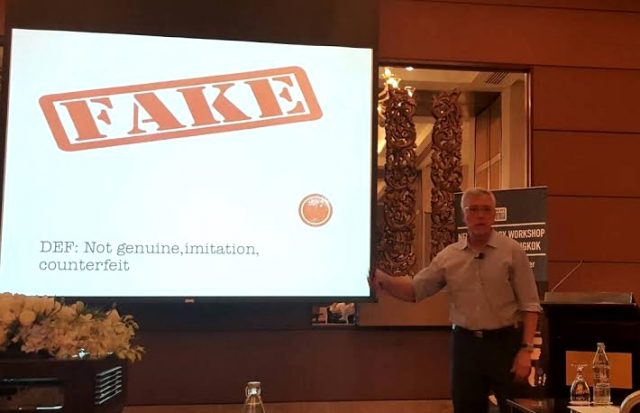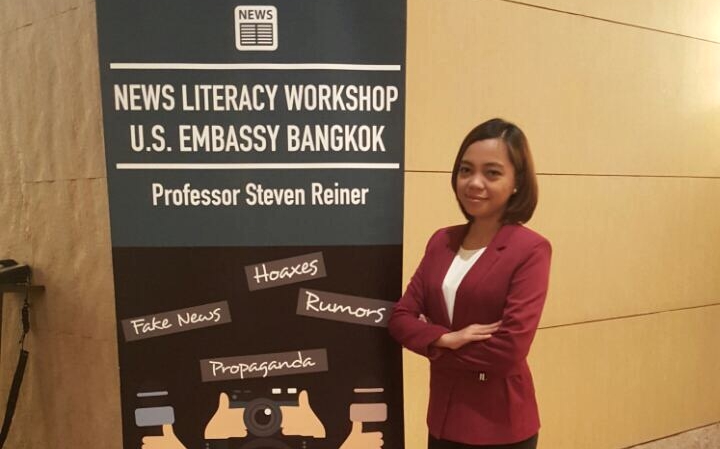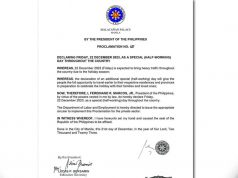
At a news literacy workshop that I attended in Bangkok, Thailand, Professor Steven Reiner, a former journalist who is Director of Broadcast and Digital Journalism at Stony Brook University, spoke about the nature of fake news, and how journalists and media consumers can spot fake news and exercise vigilance so as not to fall victim to it.

Misinformation these days spreads like wild fire. As Winston Churchill once put it, “a lie gets halfway around the world before the truth has a chance to put its pants on.”
A familiar story, especially in the Philippines, right?
How many times did we experience reposting or tweeting a statement or an article that later on turns out to be “fake news”?
Worse, before we knew we had been duped by the fake news, it had already proliferated a million-fold on social media.
The propagation of fake news is among the most serious problems many countries are now facing, as the explosion of social media and technology made it easy, and convenient, to skew not only textual information but also digitally manipulate images and videos.
Prof. Reiner said the term “fake news” is used by all sides and parties, so, these days, it is even harder to define what fake news is since “one person’s fake news could be another person’s propaganda and a source of legitimate news for another.”
One thing, however, is sure. That is, the enormous implication of fake news for the future of the press.
There is also the danger, Reiner pointed out: “Very dangerous, as it leaves people confused. When people are confused, they get lost and they become helpless. And, by then, they will just follow the strongest voice [regardless of the truth].
Needless to say, Reiner added, “democracy is in danger if people are easily duped by information.”
This is why Prof. Reiner stressed the need for news literacy. That is, the “the ability to use critical thinking skills to judge the reliability and credibility of news reports whether they come via print, television, or the internet.”
How to tell if it’s fake news?
Reiner gave out a few pointers to pick out real news from the tsunami of information they face everyday:
1. Consumers should know that real news is based on a careful process of verification. It is based on nothing less than the truth derived from evidence, such as documents, videos, photos or the first hand account of the journalist or a witness to the event.
2. A mere picture with caption is dangerous because it can be manipulated. So beware!
3. Learn how to check whether pictures are from actual events or whether they were digitally manipulated.
Reiner mentioned sites like tineye.com, fotoforensics.com, to determine whether a certain image was photoshopped.
A photo can also be dragged to Google’s reverse image functionality to check if it was exploited.
4. News consumers should also check for the independence of the news outlet that produced the article or the story.
Reiner pointed out that a trustworthy news organization is “economically and editorially independent. Its primary loyalty is to its readers and to the truth. The reader should take time to check whether an article is a “sponsored” one because it clearly has certain leanings and its truth must be selective.
5. Another thing that makes legitimate news different from fake news is that a journalist who produced the story is accountable and makes his name available and his name seen on TV or by the byline, while fake news being spread around are posted by dubious social media accounts with faceless writers using a pen name or names that you’re not sure really exist.
6. A legitimate reporter exercises transparency.
What makes a journalist accountable is that he explains how he got the story and how he knows what he knows and, should there be any information not available in the story, he also explains why.
Biased media vs audience bias
Nowadays, fake news and biased media tend to go hand in hand, with some groups or even governments accusing sections of the news media of being biased.
Reiner addressed this issue with a question: “How do we know if a news outlet is biased?”
Bias means “a predisposition that distorts your ability to fairly weigh the evidence and prevents you from reaching a fair or accurate judgment.”
For a person or entity to be branded as “biased”, Reiner said there should a pattern of unfairness over time. The professor explained that, while a certain report or story could have been poorly or unfairly done, it does not necessarily merit an outright accusation that a reporter or the news outlet is biased.
It would be helpful for news consumers to check on the following first before judging a certain news outlet or journalist of being biased:
- Look for evidence of a pattern of unfairness over time
- Compare a variety of news outlets especially when searching for bias by omission
- Take note of the self-interest of those alleging bias
But, sometimes, the reality is this: The bias is not on the media outlet but may be on the side of the news consumers.
There is what’s called “audience bias,” which manifests our desire to be on the side of people we agree with. There are people who seek out news that tends to confirm or validate what they believe in, or already know, even though news that don’t confirm what they believe in does not necessarily make the news, or the media, biased.
Admit it or not, sometimes news consumers are the ones who are biased.
How to stop fake news invasion?
In his lecture on news literacy, Prof Reiner cited the role played by people or organizations as purveyors of fake news, including:
- Digital entrepreneurs
- Propagandists
- Political partisans
- Governments
As to why fake news lives and thrives, there are a number of convincing reasons:
- Manipulates our emotions
- Satisfies confirmation or audience bias
- Encourages conspiracy thinking
- Fertile ground within a hospitable digital ecosystem
Reiner cites material produced by Washington Post on practical steps to spot fake news:
- First, if the story is too good to be true or outrageous, don’t be too eager to believe it. Try to find its source and when you can’t find a respectable news site or source, then, chances are, it’s a red flag and could have just been contrived, or made up, or fake!
- Second, always check the website or the source of news that has been posted or reposted. Many times, sources of fake news tend to be unknown or invented sites. Visit those sites and you see if it contains doubtful or dubious material.
- You can also check the site address. Some producers of fake news may come with the name of what looks like a legitimate news site, but if you check the internet address, you’ll see that it is different from the news site it pretends to be – sometimes, varying only by a single character. For example: instead of “xyz.co.” a fake news might use “xyz.c.” So, it pays to be a keen observer and to know even these little details.
- Headlines of fake news are almost always controversially written, or the headlines won’t really tell you what the meat of the story is. Lines like “you won’t believe what we saw in this respected exclusive school” could be a tell-tale sign that this is fake news.
The best way to kill fake news
Don’t be too eager in sharing, reposting or retweeting. Even using a caveat like “I can’t believe this. But check for yourselves” may still be borderline irresponsible. By doing this, we still end up unwittingly spreading fake news.
The big lesson is: Don’t post or share for the casual sake of posting or gaining comments.
The bottom line: I guess my simplest, most practical take-away from this very interesting workshop is, Don’t share without verifying. We have to be responsible news consumers. Refuse to be confused!









